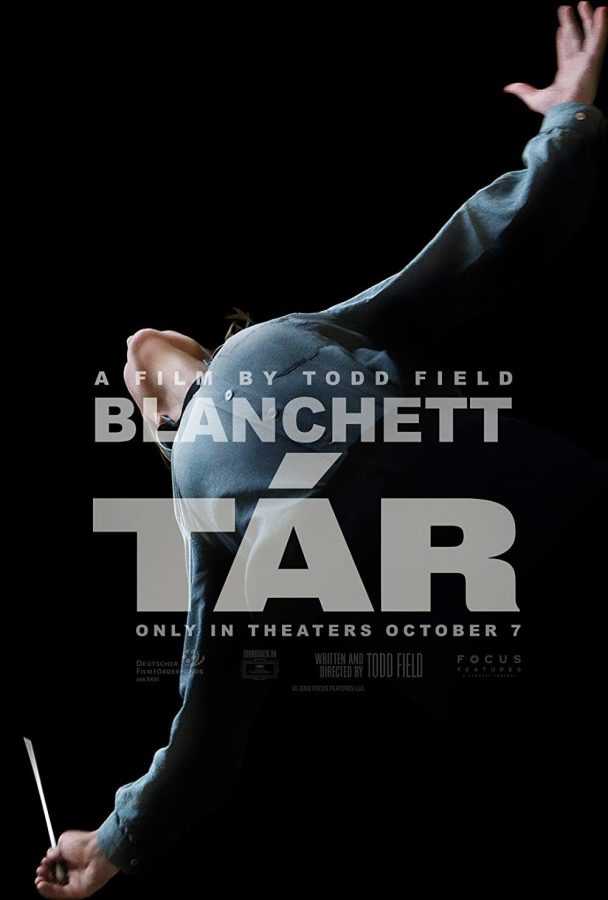“Tar” Creates a Controversy-Centered World of Its Own
“Tar,” through a seamless combination of its elements, creates a world of its own that mirrors ours to a T, giving us a unique perspective into recent controversies.
April 17, 2023
The film starts with an introduction of the main character, Lydia Tar (Cate Blanchett.) She’s a composer and maestro whose reputation is too long to list here, accomplishments including graduating from the Curtis Institute for piano performance, phi theta kappa from Harvard, and beginning her career as lead conductor of the Cleveland Orchestra. Tar’s going to be conducting the fifth and final of Mahler’s symphonies with the Berlin Philharmonic. Before then, she conducted the Boston Symphony Orchestra, a past that haunts her throughout the movie. In the present, she returns to her life in Germany, including her faltering marriage with her wife Sharon (Nina Hoss) and a dislike for one of her assistant conductors.
There’s no stop to the plot of “Tar.” We begin with an interview, which establishes the renown of the titular character. She’s famous, and that’s clear to us.
The next scene is immediately after the interview, where the composer meets a fan of hers, one who is flirtatious and she takes a liking. This is one example of one of the film’s motifs, Tar’s shifting love interests, all while in a marriage.
The logic behind these scenes– what they contribute to the story and the themes being conveyed– is seamless. They are so realistic that it makes you realize the greater meaning behind all of life, and the ease with which an event in your life could be presented as leading to some greater development.
The everyday scenes of “Tar” are what give way to the movie’s arc. What we see Tar become or, more accurately, what becomes of her. It gives us a perspective on the power-fueled sexual assault and harassment that’s been coming to light recently, one that we usually wouldn’t get, covering the rise of such a powerful figure and the catastrophe of their eventual downfall and all the suspicion of their behavior leading up to it.
The greater believability is what’s to chew on in this film, especially in scenes where we want to see the characters and actions play out, like a hypothetical that we couldn’t put together ourselves. One such scene is Tar teaching at the Julliard music school, and she argues with a student in the middle of class over their political and ideological differences that bring to light generational ones that have developed between older generations and Gen-Zers.
The reality of “Tar” is essential to the narrative beats as well, especially near the end of the film where the consequences of her actions start biting. It was in these scenes approaching the end of the movie where the framing and editing were important. In one, we see Tar pick up her and her wife Sharon’s adopted daughter Petra from school. The shot centers on Tar and Petra meeting each other at the kindergarten’s entrance and is from the view of a car’s driver-side window.
From the right of the frame, as Tar says, “Please don’t do this to me,” we see Sharon approach the two and grab Petra by the hand, walking Petra in the opposite direction Tar came in, and out of view. These details tell us that Tar and Sharon are moving in opposing directions, and their daughter is going with Sharon, both of whom are slowly disappearing from Tar’s life.
Another note to make during this scene is that the despair isn’t communicated through music. There’s no need for it. Everything the audience needs to understand in the action is there.. It generates empathy in the viewer. Empathy in a way that film can rarely capture. Empathy for a character who isn’t perfect, and whose flaws we see as we see our own.
Blanchett as Tar is superb, giving the impression that there’s no actor behind the performance. We see her nerves at the beginning of the movie, as the interview begins. She doesn’t respond initially to the interviewer’s introduction and takes a minute to start. You can see it in the way she’s breathing, too, taking deep breaths, probably focusing her thoughts.
Overall, these elements were influenced by the directing of the movie by Todd Field, whose work is shown in how seamlessly the movie blends these elements to create an enveloping world of its own. The stripped-down dialogue, editing and score work well with the careful and calculated cinematography and acting to recreate our world in profound detail. What Field does with this to illustrate the downfall of a figure such as Tar does so in a way that strongly takes neither side, presenting both the accused and accuser in a light that suggests how awful the behavior is while also showing the scornful, mocking culture that has developed around it. What the film asks the audience to do is figure out where they are in that equation.
“Tar” is by far the best movie I’ve seen this year, and will likely stay that way. You can watch it with Peacock Premium.
5/5


















